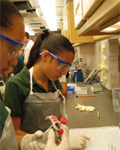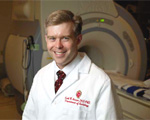IN THIS ISSUE . .
.
Fall 2007
DIRECTOR'S
MESSAGE:
Inspiring the Next Generation of Researchers
COVER STORY:
Taking Science Education on the Road
Traveling laboratories deliver engaging science lessons to classrooms everywhere.
CTSAs IN FOCUS:
Updates on the Clinical and Translational Science Awards
SCIENCE ADVANCES:
From Discovery to Market
Making novel technologies commercially available leads to advances in research and medicine.
RESEARCH BRIEFS:
Vitamin D for the Heart
Revving Up the Brain
NEWS FROM
NCRR:
People,
Awards, Grants, and New
Developments
Web Exclusives:
What's New, Upcoming Events, Funding Opportunities
This e-newsletter links to the full content of
the NCRR Reporter quarterly
magazine and to additional Web-exclusive
content. To request a free subscription to
the print magazine, contact
info@ncrr.nih.gov.
You can subscribe, change your subscription
options, or unsubscribe to this
e-newsletter by using the NCRR Reporter
subscriber page on the NIH LISTSERV Web
site.
We encourage you to forward this
e-newsletter to colleagues who may find it
of interest.
DIRECTOR'S MESSAGE:
Inspiring the Next Generation of Researchers
The mobile laboratories described in this issue grew out of NCRR's Science Education Partnership Award (SEPA) program. They are just one example of SEPA's innovative and colorful activities aimed at exciting students to pursue research careers. Read more.
COVER STORY:
Taking Science Education on the Road
Traveling laboratories deliver engaging science lessons to classrooms everywhere.

Some of the most engaging and innovative science education programs funded by NCRR travel on forty-foot-long buses equipped with state-of-the-art biotechnology equipment. These mobile laboratories, which at last count comprised at least 12 vehicles, are bringing the excitement of scientific discovery to middle and high schools across the nation. Read more.
CTSAs IN FOCUS:
Updates on the Clinical and Translational Science Awards
CTSAs Collaborate with NCRR's Science Education Programs. Across the nation, scientists at academic health centers belonging to NCRR's Clinical and Translational Science Award (CTSA) consortium work with staff from K–12 science education projects funded through NCRR's Science Education Partnership Award (SEPA) program. These interactions help fuel student interest in science. Read more.
SCIENCE ADVANCES:
From Discovery to Market
Making novel technologies commercially available leads to advances in research and medicine.

From instruments that peer deep inside cells and tissues, revealing previously unknown processes, to methods that can find signs of disease before any symptoms arise, many tools and devices used in the laboratory and clinic were developed by researchers at NCRR-funded Biomedical Technology Research Resources (BTRRs). Many BTRR discoveries have followed commercial paths, ending up as easy-to-use products in the hands of researchers and clinicians worldwide. Read more.
RESEARCH BRIEFS:
Vitamin D for the Heart
Supplements of vitamin D may not only be needed for strong bones but also help to protect against heart disease—but the same dose might not be good for everyone. Researchers at Charles R. Drew University of Medicine and Science in Los Angeles found that women, the elderly, and racial and ethnic minorities have particularly low levels of vitamin D. Read more.
Revving Up the Brain

How are people aroused from a night of blissful sleep? Researchers at the NCRR-funded Center for Translational Neuroscience in Little Rock, Ark., have found that the process involves coordinated electrical signals among particular groups of cells in the brain. Read more.
NEWS FROM NCRR:
People, Awards, Grants, and New
Developments
Web Exclusives
What's New:
Upcoming Events:
National Advisory Research Resources Council. The January 30, 2008, meeting of the NCRR's advisory council will include presentations about research conducted at the National Primate Research Centers and challenges and opportunities related to the Clinical and Translational Science Awards Program. Read draft agenda (11KB PDF file, requires free Acrobat Reader).
3rd International Conference on Primate Genomics: Primate Genomics and Human Disease. An April 2008 scientific forum where investigators in the fields of nonhuman primate research, genomics, proteomics, and bioinformatics can discuss new research findings and technological innovations related to the use of genome-based science in nonhuman primate research. The conference includes a focus on genomic and proteomic resource development, advances in computational biology and bioinformatics, and new developments in comparative genomics and evolutionary biology. Register to attend.
Funding Opportunities:
-
Biomedical Informatics Research Network Coordinating Center (U24) solicits applications to develop, deploy, and maintain key network infrastructure components, such as high-bandwidth connectivity via Internet 2, grid-based security, and more. Read more.
-
Technology Development for Biomedical Applications (R21) solicits innovative applications for the development of new and improved instruments or devices, new methodologies using existing instruments, or instrument-related software. Read more.
-
Continued Development and Maintenance of Software (R01) will support the continued development, evaluation, and testing of existing biomedical informatics and computational biology software. Read more.
-
Human Tissue and Organ Research Resource (U42) invites applications for the continued support of a human tissue and organ research resource that will facilitate procurement, preservation, and distribution of human tissue and organs to qualified biomedical researchers. Read more.
-
NCRR Science Education Partnership Award (R25) invites applications for projects that will improve understanding of the clinical trial process and health science advances stemming from NIH-funded clinical and basic research. Read more.
-
Extramural Loan Repayment Program for Clinical Researchers (LRP) invites qualified health professionals to apply for participation in the NIH Loan Repayment Program for Clinical Researchers. Read more.
|